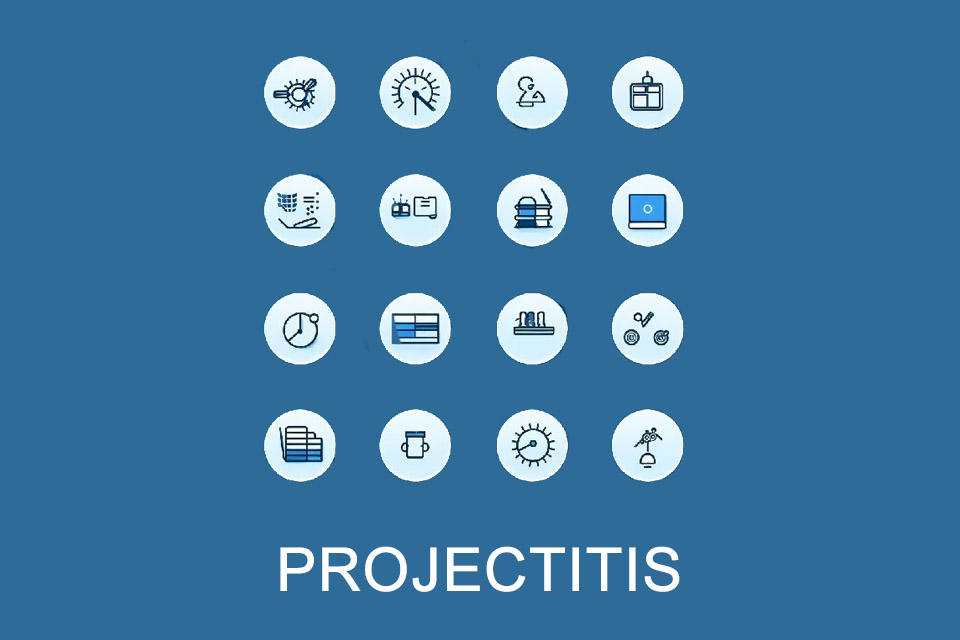What is Projectitis?
Projectitis – when suddenly everything becomes a project
“How many projects are you working on right now?”
Anyone who cannot answer such a question unambiguously – “In five, six or seven!” would not be an unambiguous answer, by the way – may be suffering from the consequences of an organisational disease: projectitis.
Projectitis is a colloquial term for an improper use of the term “project” that is not in keeping with its purpose. It is at the same time a sign that an organisation as well as its employees are overtaxed.
There are a number of institutions that define a project in different ways and with different emphases. Unfortunately, these definitions do not always help in the reality of the day-to-day business of organisations. Instead of an orderly process for project definition, many tasks are summarily defined as a project. Thus, the amount of projects per employee and in the organisation grows quickly, which can have two consequences:
- Either a project is addressed with a hodgepodge of oversized methods, which is not fit for purpose, or
- project practices that have proven useful in the past are often thrown overboard because there is simply not enough time to structure the project accordingly.
In both cases, the benefits of dedicated project management are lost.
How can projectitis be recognised?
Opinions vary when it comes to identifying projectitis. On the one hand, this is because the term is jargon in project management and not DIN 69901¹ or a definition by the Project Management Institute (PMI) or the International Project Management Association (IPMA). On the other hand, it is a feeling that gradually haunts those involved as they suffer from the expectations that come with a project. The workload simply becomes too heavy and many a “project” falls by the wayside.
So if there is no standardised definition and it is more of a feeling, how could one recognise projectitis in an organisation²:
- A sure indicator is the scenario described at the beginning where stakeholders cannot answer how many projects they are involved in. Obviously, the number is too high and there is a conspicuous lack of appropriate prioritisation by a project management office (PMO).
- The lack of defined parameters such as the client, the initial situation and the goal, possible classifications of type, risks, complexity, degree of innovation or benefit, the responsibilities, the participants and the period of participation, the contents and scope, the period from start to finish, the budget as well as the actual release is certainly also an indicator.
- Another indicator is the lack of separation between assignments, tasks and projects. Everything is quickly declared a project, even if this contradicts the actual project definition. In some organisations this can be seen in extremely different scopes: a one-person project with an effort of 2 hours, a 5-person project with an effort of 50 person-days and a 30-person project with a duration of two years. Unsurprising if the same planning care is not put into each project, isn’t it?
- And the intention behind the definition of a project can also serve as an indicator: A project often gets more attention than a “normal” line activity. This attention may also be expressed in an allocated budget. If projectitis helps to allocate financial resources, it is not surprising that employees try to use the system for specific issues, such as optimisation of work equipment, cooperation with external service providers or the use of the latest tools.
In short, there are several indicators that point to projectitis. Presumably, it is not very far-fetched to conclude an organisation’s project maturity based on the existence of the indicators, is it?
Challenges with projectitis?
There can be several challenges associated with projectitis:
- In a way, the organisation deprives itself of the opportunity to set the course for project success early on with the help of a planned, well thought-out project definition. Missing structures, unclear expectations, unclear priorities, possibly shifting contents (keyword: scope creep), make cooperation more difficult and make success control practically impossible.
- Employees are either overburdened by the workload or they take individual projects less seriously from the start because they learn from experience and the organisation virtually shows them that ineffective action is okay.
- The mood within the organisation suffers because unstructured work in the community is exhausting and not goal-oriented. With a bad mood, the results suffer. Internal and also external success declines. Pressure increases and the value of the employer brand decreases. Ouch!
And how can companies overcome the challenge of projectitis? Essentially, the only way to help is to improve the project culture. It is important to promote a common understanding of projects, to determine the concrete purpose of projects, to address the process including all parameters, contents, times and results, and to communicate clearly and comprehensibly. This sounds relatively simple on the one hand, but it is probably not, otherwise organisations would not suffer from projectitis.
The warning against projectitis by project management experts
In some publications one reads about warnings against projectitis by project management experts. An expert arguing against the existence of projects may seem unusual at first glance. At second glance, however, the whole thing is very plausible: experts live from doing a good job, from leading projects to success, from producing desired results. However, they can only succeed if the parameters are right. Only if those involved know in which direction a project should go, only if it is clear who should do what, how, with which priority and by when, then there is a chance of success. Projectitis is definitely not an indicator of success.
Impulse to discuss
How “bad” do you think it is when there is projectitis in an organisation?
Notes (partly in German):
If you like the article or would like to discuss it, please feel free to share it in your network. And if you have any comments, please do not hesitate to send us a message.
[1] DIN 69901 describes basics, processes, process model, methods, data, data models and terms in project management.
[2] More indicators are provided by Projektmagazin
Here you can download a checklist for the preparation of projects.
And here you can find additional information from our t2informatik Blog:



